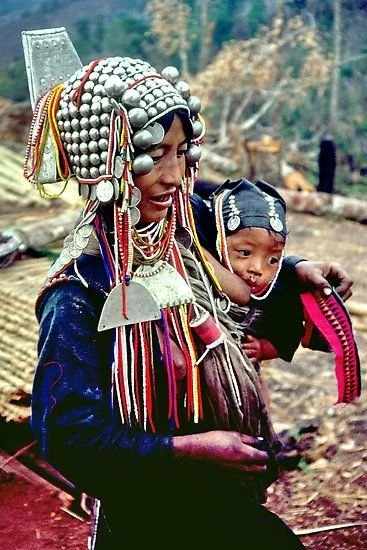Preserving Ancestral Traditions through Babywearing
Babywearing has been around for millions of years, since the first humans on earth began making baby carriers. Nomadic early humans began baby wearing to keep their little ones safe and close. Humans are biologically adapted to carry their infants. There are various cultures, traditions, and beliefs across the world because baby wearing is an instinctive and primal parenting lifestyle. Many indigenous cultures from across the globe continues to preserve their traditional childrearing practices through baby wearing, whether that’s through passing down cloth carriers, cradleboards, rattan basket carriers, etc. to the next parent-to-be within their lineage. As an ancestral birthworker, I often encourage my clients to look deep into their traditional childrearing practices from their own families and ethnic identities (if they aren’t already doing this) as part of our birth planning and postpartum planning. Preserving our ancestral traditions in the childbearing journey is an innate practice for our deep longing to belong and to be in community.
“Many carriers have multi-uses. For earlier civilizations, it made sense to carry your baby; the world was full of sickness and predators and baby carrying kept your child from becoming a target of infection, wild animals, poisonous plants, climate exposure (snow, sleet, wind, rain), and other threats to child’s health. Also, it made it easier for women, whom the family unit relied upon heavily for day-to-day functioning, to return to work much more quickly. They were able to carry about regular chores such as cooking, cleaning, harvesting, skinning, tanning, caring for other family members, and going to market, with their child, who was dependent upon them for food and comfort, in close proximity.”—CuddleBug
Benefits of Babywearing
There are many benefits of baby wearing for the birthing parent and child. Not only does baby wearing promotes attachment and bonding with baby, it also mimics the womb, helping babies feel more comfortable as they adjust to their new environment.
The physical contact of babywearing increases nurturing behaviors and secures attachment. Plus, it helps parents learn baby's cues and elevates their confidence.
Other evidence-based benefits of baby wearing includes:
Makes parent or community member be more responsive to baby, which often times makes baby cry less by soothing baby more.
Improves bodyfeeding rates.
Oxytocin flowing between parent/community member and baby, resulting in relaxation and healthy well-being for all.
Meets the many benefits of skin-to-skin and supports baby’s physical development.
May lessen postpartum depression and increase parental confidence and resilience.
And so much more!
If you are considering babywearing, remember to consult with an experienced community member/relative, babywearing consultant, or seek help from your healthcare provider.
Here is a checklist that you may find helpful for safe babywearing:
Happy Babywearing!



